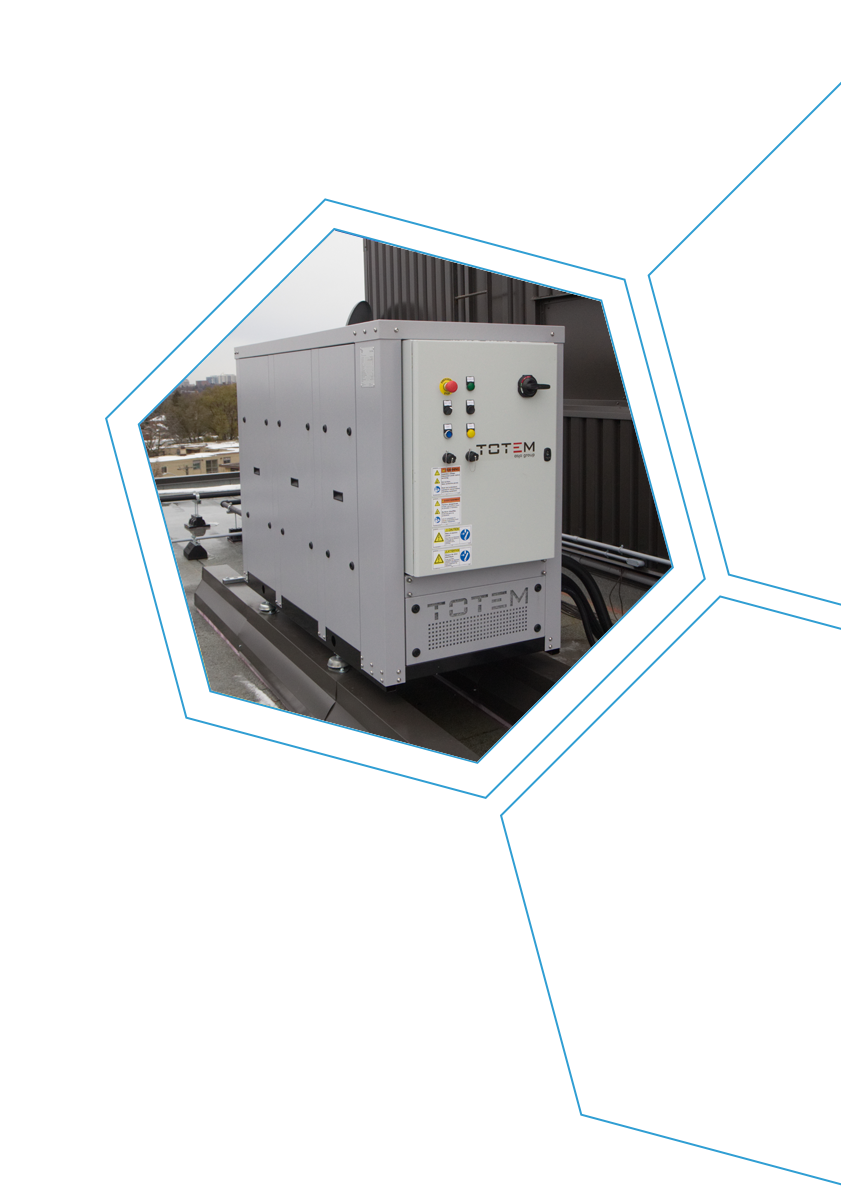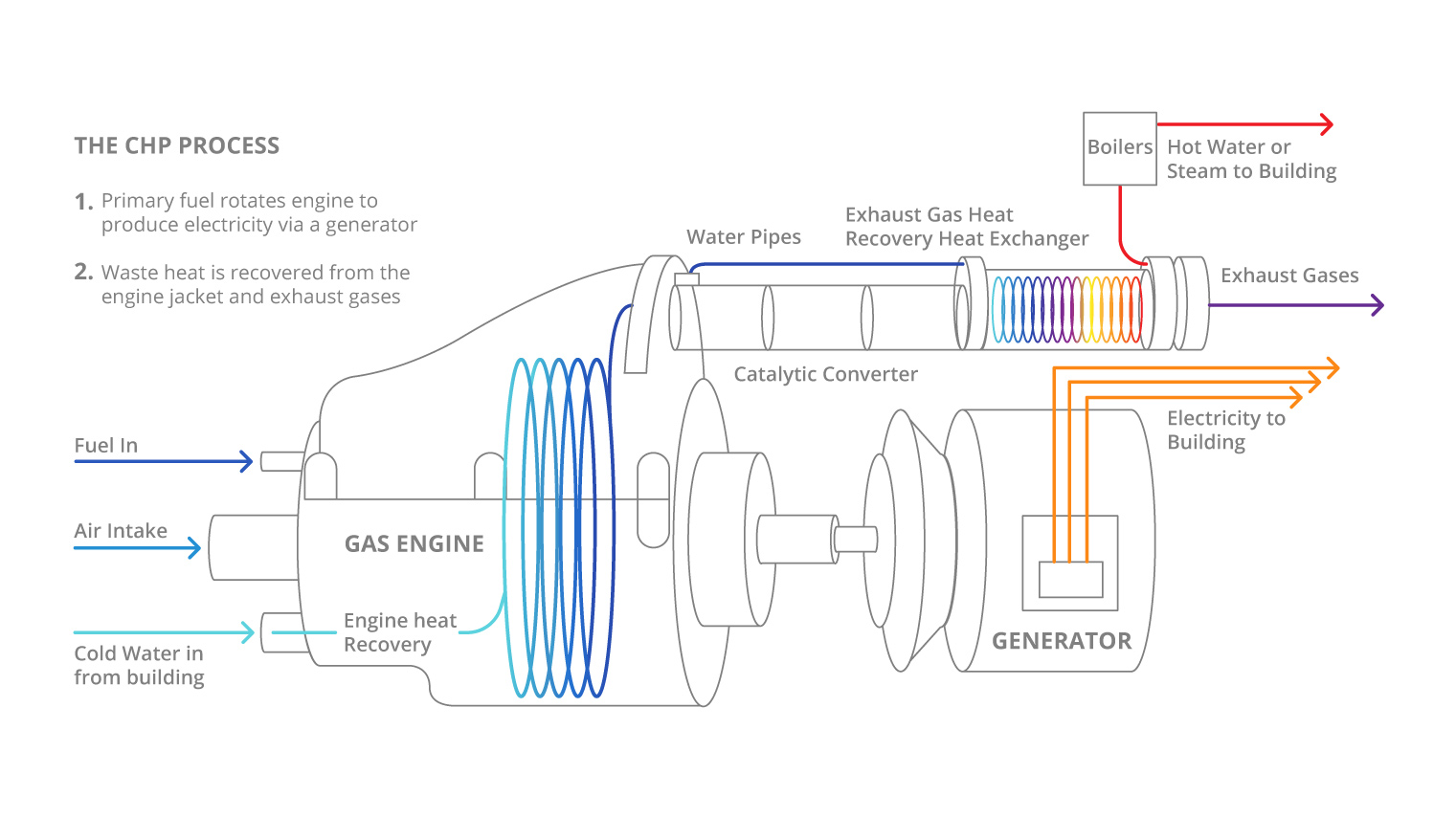dbs Power and Energy offers turnkey micro Combined Heat and Power (mCHP) solutions to Canadian businesses and residences to gain energy independence from the grid while immediately reducing energy costs and lowering CO2 emissions.
dbs Power and Energy is the leading provider of end-to-end micro Combined Heat and Power solutions in Canada. We are proud of the fact that it would take at least one full week of back-to-back site tours to visit the over 100 cogeneration installations we’ve performed in Ontario alone.
What is mCHP?
Using one source to produce electricity and thermal energy simultaneously is called cogeneration or combined heat and power (CHP). Meaning one fuel source (natural gas or alternate fuels) will generate both electricity and thermal energy (heat). Moreover, mCHP equipment is installed on the property or near the location, resulting in far less transmission loss – yet another way CHP reduces energy waste.
Micro Combined Heat and Power is simply a more compact version of the CHP technology, making it more suitable for multi-residential buildings, hospitals, schools, long term care facilities, etc. CHP is also referred to as Behind the Meter Generation solution.

BENEFITS
![DBS_CHP_Graphs_10.23.17-[Recovered]](https://dbspowerenergy.com/wp-content/uploads/2017/10/DBS_CHP_Graphs_10.23.17-Recovered-1024x797.png)
How It Works

A mCHP unit is similar to a car engine in that gas, in this case, natural gas or alternative fuels are used to fuel an engine connected to a generator which produces electricity. The thermal energy (heat) by-product from this process is then captured and distributed to meet local heat requirements. This is the reason that cogeneration is best suited for cooler climates, where there is a need for the heat. Facilities with heated pools are great candidates as well.
Three steps to a successful mCHP installation
Over the course of dbs Power and Energy history we have commissioned more Combined Heat and Power (CHP) projects than any other company in Ontario. We have an install base of over 100 mCHP units. With all that experience, we have learned a few things about successful installations and projects.
1. Choose a company with experience:
Does your developer have experience delivering successful CHP projects? Installing successful technical projects requires more than just financing experience or knowing how to put a financial model in place. Many mCHP providers are focused on selling a concept and lack the practical knowledge required to implement projects. This could pose a significant financial risk to your project – you don’t want to uncover a large hidden cost late in the process because the developer was unaware of a requirement.
Some companies might assemble teams with the right engineering disciplines but nevertheless, these teams have never had the practical experience of engineering, installing and commissioning a CHP system. Over the years, we have seen some unfathomable things, from improperly sized electrical panels to expensive and unnecessary copper pool water piping.
Don’t be a guinea pig for a mCHP company. Visit their past project sites and validate their customers’ experiences. Don’t make a decision based on a spreadsheet alone!
2. Look at the whole project:
When deciding on an mCHP solution, think about all the parts that will make up your system. For example: heat exchangers, steam generators, electrical devices, the engine, chillers. We have consistently seen sites where the mCHP unit was blamed for performance issues when in fact it was an ancillary component that was failing or improperly sized. The integrity to stand behind a product and admit fault if failure occurs is of utmost importance, which is why we’re proud to do business with 6 out of the top 12 manufacturers in the world that specialize in mCHP. Unfortunately, not all manufacturers operate that way; issues will happen and you want companies involved who want to be your partner. Having the right partners will help insure a high degree of reliability once the systems are implemented.
3. Who will do the maintenance:
After the project is complete your only relationship remains to a maintenance organization who will maintain your mCHP unit and associated equipment. It is also important to adequately consider the maintenance process during design to make sure that the system can be easily maintained throughout its life.
Next, you will want to understand the history of the company handling the maintenance. Here are some questions to ask:
-
- What experience do they have with the equipment and set up that you’ve just had installed?
- Are they licensed and qualified?
- Do they stock parts inventory?
- Do they have a history of customer satisfaction?
- What will your maintenance provider do when something breaks?
- What is their service level agreement timelines?
At dbs Power and Energy, we have a fleet of 60 trucks always ready to service our customers. Plus, we’ve added controls to our procedures, we can either make a fix remotely or make sure that the service technician is prepared with the right parts, before he even heads to the site for a diagnostic.
Energy Management
Whether we are retrofitting existing systems to be compatible with your building management system or replacing them, our experts can save you money by reducing energy consumption and increasing system efficiency.
Whether we are retrofitting existing systems to be compatible with your building management system or replacing them, our experts can save you money by reducing energy consumption and increasing system efficiency.
Our process starts with a full building audit to establish energy baselines, and identifies areas of improvement. Once the audit is complete, we review our findings with the customer and work together to create an energy management plan that suits their needs. The energy baseline that is established allows us to monitor the impact of implemented measures, and track their performance. Energy management is an ongoing process that requires continuing mitigation and analysis to achieve maximum efficiency.
Support & Maintenance
Being an end-to-end provider, we source the best solution for you, install it, and service the equipment to ensure it is running optimally. In the event of an issue, you contact dbs, and we will come to you, not sub-contractors. Which allows us to maintain the integrity of our work and keep our customers satisfied.
